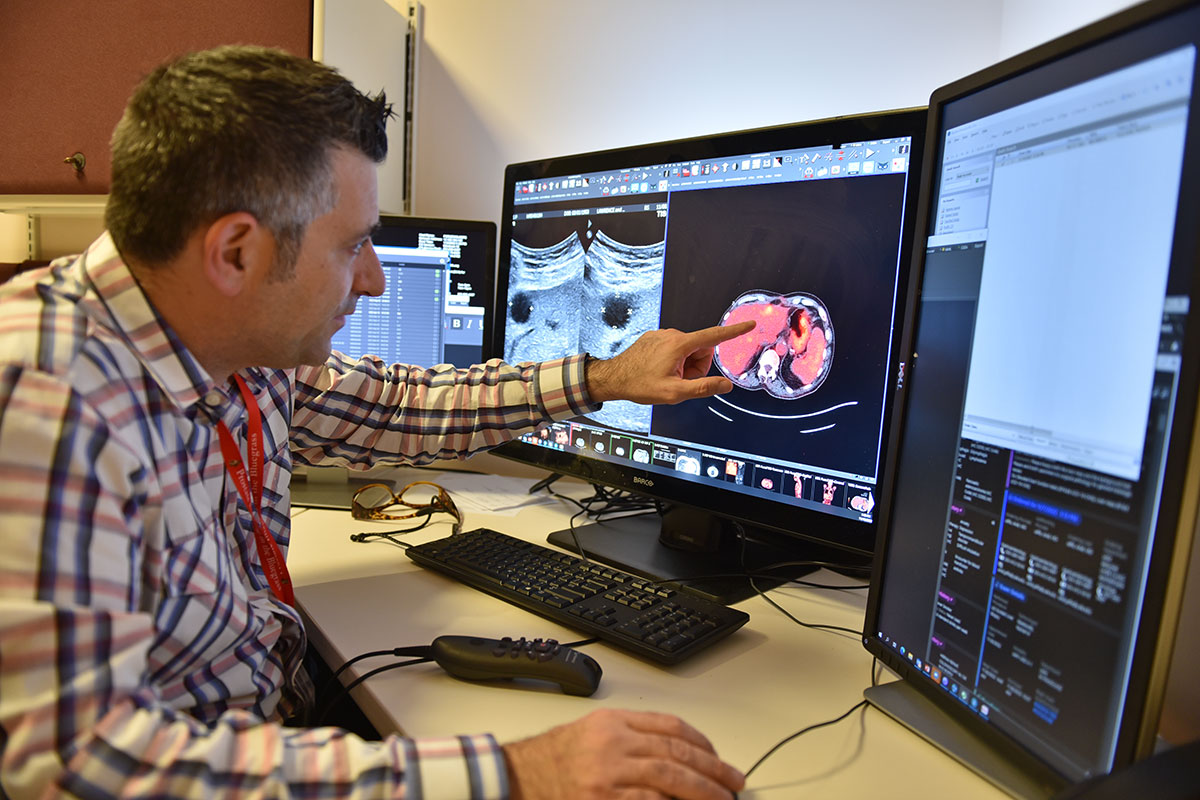
Louis Mazzarelli, MD, reviews images from a contrast ultrasound, a technology helping to better diagnose, biopsy and study lesions in a variety of organs, thereby providing new options to help patients
Louis Mazzarelli, MD, loves bubbles, but not just any kind of bubble.
As a radiologist at L+M Hospital, Dr. Mazzarelli is specifically enamored with tiny gas-filled microbubbles – each the size of a red blood cell – that are now being used as a cutting-edge contrast agent for ultrasound.
“Using these bubbles to diagnose, biopsy and track cancers – it’s a diagnostic game-changer,” Dr. Mazzarelli said. “The technology has been used in Europe for some time, but it’s really coming into its own here in the United States. I call it a dynamic contrast tool because it has so many applications.”
Extensive clinical evidence has demonstrated that the technology is safe, comparing well with conventional agents used in CT scans and magnetic resonance imaging (MRI).
“It has an exceptional safety profile, it’s well tolerated, and can be utilized for patients who have renal dysfunction or renal failure,” Dr. Mazzarelli said. “It can be used for patients who cannot have an MRI or for patients allergic to other contrast agents. It’s another way for us to be more definitive about a patient’s diagnosis.”
Dr. Mazzarelli said he considers the new contrast ultrasound complimentary with MRI and CT imaging.
“As good as these other modalities are sometimes we still can’t get to the answer,” he said. “But, with these bubbles, being the size of red blood cells, the contrast stays in the vessels. The way the bubbles wash in and out of organs enables us to see lesions sometimes better than even CT and MRI. There are features to lesions that enable us to distinguish cancer and not cancer very readily with the contrast bubbles, which we sometimes can’t see as clearly with CT or MRI.”
In short, the microbubble contrast agent gives doctors another powerful option to help diagnose patients with safety and accuracy, and it can be the best choice for some patients. For example, if a patient cannot undergo MRI because of an implanted device such as a pacemaker, a contrast ultrasound might be the best approach. Ultrasound technology is also free of radiation exposure for patients.
Biopsies also benefit from the microbubbles. “Contrast-assisted biopsies with ultrasound allow us to put our needle in the part of the tumor that’s most viable, so we’re more likely to get biopsies that are two things: they’re more likely to be diagnostic, and they will have a higher yield of the actual tumor,” Dr. Mazzarelli said. This increased biopsy accuracy can be vital to pathology which can help doctors determine the best method of treatment for a specific cancer.
“We’re also using this technology therapeutically in cases where we’ve done a procedure to try to kill or remove a tumor, and we need to see if there’s any tumor left,” Dr. Mazzarelli continued. “The fidelity of these ultrasound images is amazing. We’re able to do and see things that we really couldn’t do or see in the past.”
More doctors are taking advantage of the technology to benefit patients, Dr. Mazzarelli noted. “We’re using it in the liver, in the kidney, the ovary, the spleen, the scrotum and testicles. We can use it in soft tissues and in the GI tract to look at the bowel. I call it a dynamic contrast tool because of this wide applicability.”
A tireless advocate for the latest imaging technologies, Dr. Mazzarelli has also championed other programs, such as low-dose CT scans to detect lung cancers in long-term smokers. “I love bringing new modalities to our hospitals,” he said. “I love it because our patients have the opportunity to benefit from some great technology, and that’s very exciting.”




